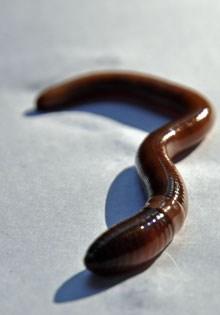Amynthas spp. (CABI)
Asian jumping worm, Asian crazy worm, Alabama jumper
East-central Asia (Laushman et al. 2018)
Present in the U.S. since the late 1800s, but has been recently invading natural habitats in the Northeast and Midwest (Laushman et al. 2018; Schult et al. 2016)
Possibly through the horticultural trade or by anglers using them as bait (Snyder et al. 2011)
Affects forest habitats by altering soil properties, resulting in reduced food resources for native species (Schult et al. 2016)

Asian Jumping Worms have a wide clitellum (band) around their bodies
Photo by National Park Service.
Find more images
Spotlights
Distribution / Maps / Survey Status
All Resources
Selected Resources
The section below contains highly relevant resources for this species, organized by source.
Council or Task Force
Partnership
Federal Government
State and Local Government
Academic
Professional
CABI. Invasive Species Compendium. Amynthas agrestis. CAB International. [Accessed Mar 12, 2023].
Laushman, K.M., S.C. Hotchkiss, and B.M. Herrick. 2018. Tracking an invasion: community changes in hardwood forests following the arrival of Amynthas agrestis and Amynthas tokioensis in Wisconsin. Biological Invasions 20(1671–1685).
Schult, N., K. Pittenger, S. Davalos, and D. McHugh. 2016. Phylogeographic analysis of invasive Asian earthworms (Amynthas) in the northeast United States. Invertebrate Biology 135(4):314-327.
Snyder, B.A., M.A. Callaham Jr., and P.F. Hendrix. 2011. Spatial variability of an invasive earthworm (Amynthas agrestis) population and potential impacts on soil characteristics and millipedes in the Great Smoky Mountains National Park, USA. Biological Invasions 13(349–358).
